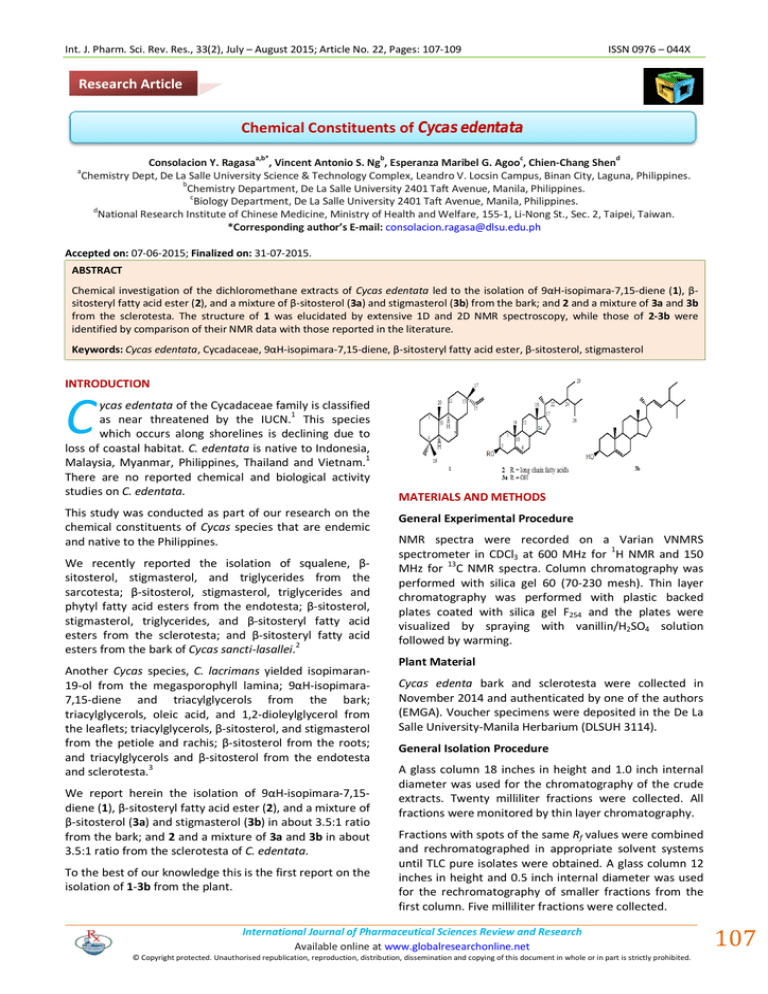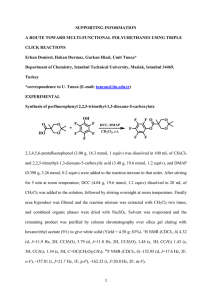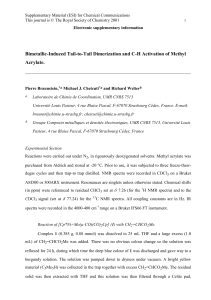Document 13310565
advertisement

Int. J. Pharm. Sci. Rev. Res., 33(2), July – August 2015; Article No. 22, Pages: 107-109 ISSN 0976 – 044X Research Article Chemical Constituents of Cycas edentata a,b* a b c d Consolacion Y. Ragasa , Vincent Antonio S. Ng , Esperanza Maribel G. Agoo , Chien-Chang Shen Chemistry Dept, De La Salle University Science & Technology Complex, Leandro V. Locsin Campus, Binan City, Laguna, Philippines. b Chemistry Department, De La Salle University 2401 Taft Avenue, Manila, Philippines. c Biology Department, De La Salle University 2401 Taft Avenue, Manila, Philippines. d National Research Institute of Chinese Medicine, Ministry of Health and Welfare, 155-1, Li-Nong St., Sec. 2, Taipei, Taiwan. *Corresponding author’s E-mail: consolacion.ragasa@dlsu.edu.ph Accepted on: 07-06-2015; Finalized on: 31-07-2015. ABSTRACT Chemical investigation of the dichloromethane extracts of Cycas edentata led to the isolation of 9αH-isopimara-7,15-diene (1), βsitosteryl fatty acid ester (2), and a mixture of β-sitosterol (3a) and stigmasterol (3b) from the bark; and 2 and a mixture of 3a and 3b from the sclerotesta. The structure of 1 was elucidated by extensive 1D and 2D NMR spectroscopy, while those of 2-3b were identified by comparison of their NMR data with those reported in the literature. Keywords: Cycas edentata, Cycadaceae, 9αH-isopimara-7,15-diene, β-sitosteryl fatty acid ester, β-sitosterol, stigmasterol INTRODUCTION C ycas edentata of the Cycadaceae family is classified as near threatened by the IUCN.1 This species which occurs along shorelines is declining due to loss of coastal habitat. C. edentata is native to Indonesia, Malaysia, Myanmar, Philippines, Thailand and Vietnam.1 There are no reported chemical and biological activity studies on C. edentata. This study was conducted as part of our research on the chemical constituents of Cycas species that are endemic and native to the Philippines. We recently reported the isolation of squalene, βsitosterol, stigmasterol, and triglycerides from the sarcotesta; β-sitosterol, stigmasterol, triglycerides and phytyl fatty acid esters from the endotesta; β-sitosterol, stigmasterol, triglycerides, and β-sitosteryl fatty acid esters from the sclerotesta; and β-sitosteryl fatty acid esters from the bark of Cycas sancti-lasallei.2 Another Cycas species, C. lacrimans yielded isopimaran19-ol from the megasporophyll lamina; 9αH-isopimara7,15-diene and triacylglycerols from the bark; triacylglycerols, oleic acid, and 1,2-dioleylglycerol from the leaflets; triacylglycerols, β-sitosterol, and stigmasterol from the petiole and rachis; β-sitosterol from the roots; and triacylglycerols and β-sitosterol from the endotesta 3 and sclerotesta. We report herein the isolation of 9αH-isopimara-7,15diene (1), β-sitosteryl fatty acid ester (2), and a mixture of β-sitosterol (3a) and stigmasterol (3b) in about 3.5:1 ratio from the bark; and 2 and a mixture of 3a and 3b in about 3.5:1 ratio from the sclerotesta of C. edentata. To the best of our knowledge this is the first report on the isolation of 1-3b from the plant. MATERIALS AND METHODS General Experimental Procedure NMR spectra were recorded on a Varian VNMRS spectrometer in CDCl3 at 600 MHz for 1H NMR and 150 MHz for 13C NMR spectra. Column chromatography was performed with silica gel 60 (70-230 mesh). Thin layer chromatography was performed with plastic backed plates coated with silica gel F254 and the plates were visualized by spraying with vanillin/H2SO4 solution followed by warming. Plant Material Cycas edenta bark and sclerotesta were collected in November 2014 and authenticated by one of the authors (EMGA). Voucher specimens were deposited in the De La Salle University-Manila Herbarium (DLSUH 3114). General Isolation Procedure A glass column 18 inches in height and 1.0 inch internal diameter was used for the chromatography of the crude extracts. Twenty milliliter fractions were collected. All fractions were monitored by thin layer chromatography. Fractions with spots of the same Rf values were combined and rechromatographed in appropriate solvent systems until TLC pure isolates were obtained. A glass column 12 inches in height and 0.5 inch internal diameter was used for the rechromatography of smaller fractions from the first column. Five milliliter fractions were collected. International Journal of Pharmaceutical Sciences Review and Research Available online at www.globalresearchonline.net © Copyright protected. Unauthorised republication, reproduction, distribution, dissemination and copying of this document in whole or in part is strictly prohibited. 107 © Copyright pro Int. J. Pharm. Sci. Rev. Res., 33(2), July – August 2015; Article No. 22, Pages: 107-109 Final purifications were conducted using Pasteur pipettes as columns. One milliliter fractions were collected. Isolation of the Chemical Constituents of the Bark The air-dried bark of C. edentata (144 g) were ground in a blender, soaked in CH2Cl2 for 3 days and then filtered. The solvent was evaporated under vacuum to afford a crude extract (0.7 g) which was chromatographed using increasing proportions of acetone in CH2Cl2 at 10% increment. The CH2Cl2 fraction was rechromatographed (3 ×) using petroleum ether to afford 1 (3 mg) after washing with petroleum ether. ISSN 0976 – 044X 29.52, 29.47, 29.36, 29.34, 29.32, 29.27, 29.25, 29.16, 29.13, 29.10, 29.08, 27.80, 27.21, 27.19, 27.16, 26.39, 26.04, 25.62, 25.06, 25.04, 24.28, 23.42, 23.05, 22.69, 22.57 (CH2), 130.21, 130.06, 129.98, 129.76 (CH=), 14.12, 14.07 (terminal CH3). β-Sitosterol (3a): 13C NMR (150 MHz, CDCl3): δ 37.24 (C1), 31.65 (C-2), 71.81 (C-3), 42.31 (C-4), 140.74 (C-5), 121.72 (C-6), 31.89, 31.90 (C-7, C-8), 50.14 (C-9), 36.49 (C10), 21.07 (C-11), 39.76 (C-12), 42.20 (C-13), 56.75 (C-14), 24.35 (C-15), 28.24 (C-16), 56.03 (C-17), 11.97 (C-18), 19.39 (C-19), 36.14 (C-20), 18.77 (C-21), 33.93 (C-22), 26.04 (C-23), 45.82 (C-24), 29.13 (C-25), 19.02 (C-26), 19.81 (C-27), 23.05 (C-28), 11.85 (C-29). The 30% acetone in CH2Cl2 fraction was rechromatographed (4 ×) in CH3CN:Et2O:CH2Cl2 (0.5:0.5:9 by volume) to yield a mixture of 3a and 3b (4 mg) after washing with petroleum ether. Stigmasterol (3b): 13C NMR (150 MHz, CDCl3): δ 37.24 (C1), 31.65 (C-2), 71.81 (C-3), 42.29 (C-4), 140.74 (C-5), 121.72 (C-6), 31.89 (C-7, C-8), 50.11 (C-9), 36.49 (C-10), 21.09 (C-11), 39.67 (C-12), 42.20 (C-13), 56.85 (C-14), 24.35 (C-15), 28.92 (C-16), 55.93 (C-17), 12.04 (C-18), 19.39 (C-19), 40.49 (C-20), 21.09 (C-21), 138.31 (C-22), 129.25 (C-23), 51.23 (C-24), 31.89 (C-25), 21.20 (C-26), 18.97 (C-27), 25.40 (C-28), 12.25 (C-29). Isolation of the Chemical Constituents of the Sclerotesta RESULTS AND DISCUSSION The air-dried sclerotesta of C. edentata (48 g) were ground in a blender, soaked in CH2Cl2 for 3 days and then filtered. The solvent was evaporated under vacuum to afford a crude extract (0.1 g) which was chromatographed using increasing proportions of acetone in CH2Cl2 at 10% increment. Silica gel chromatography of the dichloromethane extracts of C. edentata yielded 1-3b from the bark; and 23b from the sclerotesta. The 10% acetone in CH2Cl2 fraction was rechromatographed (2 ×) in 5% EtOAc in petroleum ether to yield 2 (2 mg) after washing with petroleum ether. The CH2Cl2 fraction was rechromatographed (3 ×) in 5% EtOAc in petroleum ether to yield 2 (2 mg) after washing with petroleum ether. The 40% acetone in CH2Cl2 fraction was rechromatographed (2 ×) in 20% EtOAc in petroleum ether to yield a mixture of 3a and 3b (7 mg) after washing with petroleum ether. 9αH-Isopimara-7,15-diene (1): 1H NMR (600 MHz, CDCl3): δ 0.85 (6H, s, H-17, H-20), 0.86 (3H, s, H-18); 0.90 (3H, s, H-19), 4.85 (d, J=10.8 Hz, H-16), 4.92 (d, J=17.4 Hz, H-16), 5.34 (brs, H-7), 5.80 (dd, J=17.4, 10.8 Hz, H-15). 13CNMR (150 MHz, CDCl3): δ 14.94 (C-20), 18.85 (C-2), 20.19 (C11), 21.46 (C-17), 22.69 (C-19), 23.46 (C-6), 32.82 (C-4), 33.62 (C-18), 35.43 (C-10), 36.22 (C-12), 37.38 (C-13), 39.87 (C-1), 42.28 (C-3), 46.18 (C-14), 50.38 (C-5), 52.00 (C-9), 109.13 (C-16), 121.68 (C-7), 135.52 (C-8), 150.50 (C15). β-Sitosteryl Fatty Acid Esters (2):13C NMR (150 MHz, CDCl3): δ 36.99 (C-1), 31.52 (C-2), 73.68 (C-3), 42.30 (C-4), 139.71 (C-5), 122.58 (C-6), 32.19, 31.92 (C-7, C-8), 50.01 (C-9), 36.15 (C-10), 21.02 (C-11), 39.71(C-12), 42.30 (C13), 56.67 (C-14), 24.28 (C-15), 28.24 (C-16), 56.01(C-17), 11.84 (C-18), 19.32 (C-19), 36.59 (C-20), 19.02 (C-21), 33.92 (C-22), 29.13 (C-23), 45.82 (C-24), 26.04 (C-25), 18.76 (C-26), 19.81 (C-27), 23.05 (C-28), 11.97 (C-29), 173.30 (C-1'), 34.70 (C-2'), 29.76, 29.70, 29.65, 29.59, The structure of 1 was elucidated by extensive 1D and 2D NMR spectroscopy and confirmed by comparison of its NMR data with those reported in the literature for 9αHisopimara-7,15-diene.2 Compounds 2-3b were identified by comparison of their NMR data with those reported in the literature for βsitosteryl fatty acid ester (2),3 β-sitosterol (3a),4 and stigmasterol (3b).4 The mixture of 3a and 3b in about 3.5:1 ratio was deduced from the 1H NMR resonances for the olefinic protons of 3a at δ 5.33 (dd, J=1.8, 5.4 Hz, H-6) and 3b at δ 5.33 (dd, J=1.8, 5.4 Hz, H-6), 5.13 (dd, J=9.0, 15.0 Hz, H22) and 5.00 (dd, J=9.0, 15.0 Hz, H-23).5 Acknowledgement: A research grant from the Commission on Higher Education–Philippine Higher Education Research Network (CHED–PHERNet) of the Philippines is gratefully acknowledged. REFERENCES 1. Osborne R, Hill KD, Nguyen HT, Phan KL. 2010. Cycas edentata. The IUCN Red List of Threatened Species. Version 2015.1. <www.iucnredlist.org>. Downloaded on 04 June 2015. 2. Ng VAS, Agoo EM, Shen C-C, Ragasa CY. Chemical constituents of Cycas sancti-lasallei. J Appl Pharm Sci., 5 Suppl 1, 2015, 12–17. 3. Ng VAS, Agoo EM, Shen C-C, Ragasa CY. Chemical constituents of Cycas lacrimans. Int J Pharmacog Phytochem Res., 7(3), 2015. International Journal of Pharmaceutical Sciences Review and Research Available online at www.globalresearchonline.net © Copyright protected. Unauthorised republication, reproduction, distribution, dissemination and copying of this document in whole or in part is strictly prohibited. 108 © Copyright pro Int. J. Pharm. Sci. Rev. Res., 33(2), July – August 2015; Article No. 22, Pages: 107-109 4. Ragasa CY, Ebajo Jr V, Ng VAS, De Los Reyes MM, Shen C-C. Chemical constituents of Strongylodon macrobotrys, Der Pharma Chemica, 6(6), 2014a, 366–373. 5. ISSN 0976 – 044X Ragasa CY, Buluran AI, Mandia EH, Shen C-C. Chemical constituents of Cayratia trifolia. Der Pharma Chemica, 6(6), 2014b, 418–422. Conflict of Interest: None. International Journal of Pharmaceutical Sciences Review and Research Available online at www.globalresearchonline.net © Copyright protected. Unauthorised republication, reproduction, distribution, dissemination and copying of this document in whole or in part is strictly prohibited. 109 © Copyright pro




